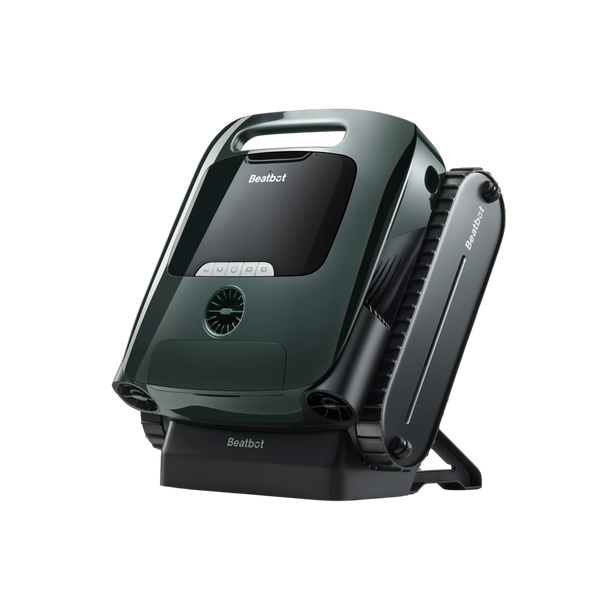Effortless Pool Maintenance: Revolutionize Salt Cell Cleaning with Robotic Cleaners
2024-03-24
Not only is keeping your pool sparkling cosmetic; it’s necessary for safety, hygiene and the longevity of your equipment. A significant part of saltwater pools is the salt cell, which creates the chlorine needed to keep your pool sparkling. It is also subject to calcium deposits and debris over time that may hinder its efficiency. Keeping it clean is an ongoing process, but robotic pool cleaners, such as the Beatbot AquaSense Series, make that task a walk in the park. We’ll delve into the benefits of salt cell maintenance and detailed how these modern-day cleaners can simplify taking care of your pool.
Table of content

Understanding the Role of the Salt Cell
Salt cells, or chlorinators, are the heart of saltwater pool systems. They transform dissolved salt into chlorine, a sanitary treatment that disinfects the pool water, killing bacteria and algae. Saltwater pools provide a gentler, more comfortable swimming experience than traditional chlorine pools and require less direct chemical handling. But as the salt cell does its thing, it can also become calcified with calcium and minerals that are naturally in the water.
As time passes, these deposits (which are often called scale) can make the electrode plates in the salt cell become blocked and result in less efficient operation. Not only does this affect water quality, but also puts an undue burden on your pool system that will result in potential expensive repairs. It also makes sure the salt cell, that balances your pool, works effectively.
Signs Your Salt Cell Needs Cleaning
Before jumping into the cleaning process, it is important to know when your salt cell may be in need of some attention. A sudden drop in chlorine levels, even if the pool functions as it should, is usually indicative of a problem. Test the water: Cloudy or murky water, despite the pump and filter operating properly, can also indicate an issue. A good warning sign of the salt cell needing preventative maintenance is visible white calcium deposits on the salt cell plates themselves along with error messages from your pool system controller indicating reduced efficiency. These are the warning signs and indicates you need to clean the salt cell. For traditional cleaning methods that include scrubbing and soaking, it can ease this task because all you need is simply taking advantages of a robotic swimming pool cleaner.
Robotic Pool Cleaners: A Game-Changer for Pool Maintenance
Efficiency in Debris Collection and Scrubbing
Robotic pool cleaners are the unsung heroes of modern pool maintenance. From things like debris collection to pool surface scrubbing, these are meant to keep your pool as free of muck as possible while you do the least amount of manual labor possible. However, can they help to clean salt cells? Absolutely.
Innovative Technology in the Pool Cleaning Arena
Robotic pool cleaners like the Beatbot AquaSense Series give innovative technologies a strong run in the pool cleaning arena. Despite their main purpose being to scour floors, walls, and water lines of pools, it can still be a great best-practice for overall hygiene of the pool system as the precision and versatility of pool cleaners can be an excellent method for cleaning.
Keeping Contaminants from Salt Cells
By effectively clearing the debris from your swimming pool, robotic cleaners help keep contaminants from going through the filtration system and settling on the salt cell. Having pool water that is clear and free, reduces the amount of calcium deposited, which means less frequent manual cleanings.
Enhanced Water Circulation
Moreover, robotic pool cleaners increase water circulation when they travel across the pool in a systematic manner. In addition, enhanced circulation enables the salt cell to work more efficiently and minimizes stagnant areas, which can worsen scaling problems.
Specialized Cleaning Attachments
Certain high-end robotic cleaners also feature attachments or brushes specialized for detailed cleaning jobs. These tools provide a simple step and powerful way to clean salt cells quickly and without harmful chemicals or scrubbing.
How to Clean Your Salt Cell Using a Robotic Pool Cleaner
Select the Right Robotic Cleaner
Choose a premium robotic pool cleaner, like the Beatbot AquaSense Series, which possesses custom add-ons or brushes for thorough cleaning tasks. These cleansers work general dirt, and also the cleaning needs of the location of sunlight crystals.
Pre-clean Your Pool
Before you begin, be sure to remove any larger debris, like leaves or twigs, from your pool by hand. This way, when the robotic cleaner comes to do its job, it can do a much more precise clean without larger obstructions getting in the way and disturbing the cleaner's abilities.
Run the Cleaner
Drop the robotic cleaner into the pool and set it to automatic per the manufacturer’s instructions. Let the cleaner run through its entire cycle, such as scrubbing the floor, walls and water line. It clears away debris that would otherwise settle on the salt cell eventually.
Focus on Salt Cell Area
Utilize the specific attachments for the robotic cleaner to concentrate on the salt cell region. Some cleaners are equipped with special brushes or jets designed specifically to gently but effectively clean the salt cell without damaging the cell itself. Overview of Cell Pre-treatment This step is critical in eliminating any contaminants that might negatively affect the cell's performance.
Control the Cleaning Process
It would help to have a pool robot with planning and navigation functions.With a Beatbot AquaSense Pro, you don't need to keep an eye on the robotic pool cleaner as it works. All you need to do is wait for the machine to finish cleaning, return to the surface of the water, and lift it out. Then, you can check all the processes and data with an app on your phone.
Inspect the Results
Once the cleaning cycle is complete, carefully inspect the salt cell to ensure that all deposits and scaling have been effectively removed.
Maintain Regular Cleaning
Make the robotic cleaner a part of your regular maintenance to keep the pool and salt cell in top shape. Using the cleaner regularly will keep all debris from accumulating, making manual cleaning less frequent and preventing scaling.

The Beatbot AquaSense Advantage
The Beatbot AquaSense Series robotic technology will change your perception of pool maintenance. Offering intelligent navigation, precision cleaning brushes, and eco-friendly operation, it’s an all-in-one ally in your pool cleaning efforts. Although its primary purpose involves addressing pool surfaces, its versatility extends to providing support in preserving other essential elements, such as the salt cell, keeping your pool in top-notch shape throughout the seasons.
Preventative Measures to Extend Salt Cell Lifespan
When it comes to cleaning the pool, robotic cleaners indeed make it easier, but taking extra steps to prevent damage to your salt cell can go a long way in extending its lifespan. Frequent salt level checking, the right water chemistry, and consistent filtration in the system are essential steps. Covering your pool with a good pool cover reduces debris activity and can help reduce load on your salt cell and robotic cleaner.
A Modern Approach to Pool Care
Adding robotic pool cleaners to your exercise regimen is a step toward smarter, effort-saving maintenance. You're not just fighting the visible signs of pool cleaning, but tackling those hidden elements like salt cell hygiene — for a healthier swimming experience for years to come.
You can check it out here: Beatbot AquaSense Series: Making your pool maintenance simple and fun Ditch the hard scrubbing with this device to get clean water without the effort. Whether you are basking poolside or entertaining for summer, you can enjoy the peace of mind that your pool system is in the hands of experts.
Cleaning a pool isn't just about bringing a physical space to life; it's about creating a place where memories are made. With a robotic cleaner by your side, you’ll spend more time enjoying life’s precious moments—and less time fretting over the details.
Relative Blogs
About the author



















